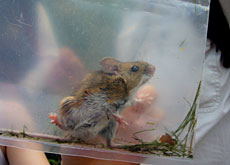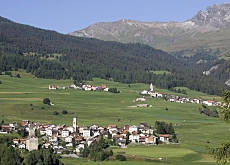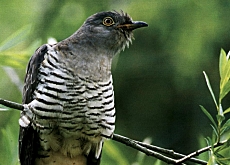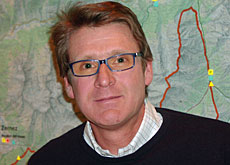New park puts itself on the map

One of Switzerland's best-kept secrets is on its way to being revealed to a wider public.
The Valais area in the southwest of the country is famous for mountains such as the Matterhorn, but the Pfynwald – or Pfyn forest – in the Rhone valley is scarcely known outside its immediate area, even though it is full of interest and considerably easier to explore.
That is now changing, thanks to a new law on Swiss parks due to come into force in 2009, aimed at promoting the tourism potential of sites of exceptional natural interest.
The Pfynwald is an unusual mixture of dry hills with small lakes in the hollows between them. It has long been a focus of attention for biologists; now the general public are being invited to share in that interest.
The forest was declared a cantonal park in 2005. As a result, measures are being taken to protect it and it now has a staff, paid by the Valais cantonal authorities. Their aim is to get it accepted as a regional park under the new law.
The park team has been experimenting with organised excursions with a limited number of participants, aimed at raising awareness of the natural environment.
Balance
However, a careful balance has to be struck between drawing visitors to the park and preserving the nature that makes it special.
“We would like to make some parts of the park very attractive for people, and keep them out of other parts,” park director Peter Oggier explained.
The excursions started in 2006 are carefully evaluated at the end of the season.
“We don’t know at the moment what will be the limit of people we can accept,” said Muriel McGeorge, communications manager for the Pfynwald. “It’s like a baby we are watching growing at the moment.”
But biologist Paul Marchesi, who has long been pushing for the creation of a park, is not worried about visitor numbers. If animals are not hunted, they will not hide as long as people stick to the paths, he says.
Discover nature
The aim of a park is to allow people to discover nature, and for this the Pfynwald is ideal.
“We have a lot of animals in Valais, but you never see them. If you want to see large mammals, you have to walk eight hours to get to the top of a mountain, whereas here in the Pfynwald in an hour’s walk from the station you can see deer, chamois, beaver and so on,” Marchesi told swissinfo.
As a leader of Pfynwald excursions, Marchesi knows how to interest the public not only in the forest’s fauna but also in the work of biologists.
He has prepared his excursion on small mammals by setting a number of traps. He explains to the group how the traps work, and the precautions taken to prevent the animals from suffering stress. Then, as the group waits with bated breath, he gently opens a trap into a large plastic sack so the occupant can be seen more clearly.
Most of the traps have been sprung by field mice. Marchesi explains the characteristics of the animal and how to distinguish the two very similar species found in the wood. Then the bag is opened and the mouse is off and away into the undergrowth.
The group learns how to play the detective with animal droppings, finds out how to determine whether the owner of a pile of feathers was killed by a fox or a bird of prey, and sees the tell-tale signs of a deer’s passing in the shredded bark of a young willow tree.
Everyone, from the gaggle of young children to the lady who admits that in truth she is afraid of mice, is satisfied with their visit. The Pfynwald is well on the way to putting itself on the map.
swissinfo, Julia Slater, Pfynwald
The forest known as the Pfynwald in German and the Bois de Finges in French lies on the left bank of the Rhone between Leuk and Sion.
It is close to the boundary between the German and French speaking parts of Valais.
It was made into a cantonal park in 2005 and hopes to be recognised as a regional park under a law coming into force in 2009.
The current area is 17 sq km; the park team hopes to extend it to 120 sq km.
The easily accessible area consists of a mixture of dry hills and small lakes, but it also includes the slopes of the mountains rising above it.
A specially adapted wheelchair is available for use on the narrow paths.

In compliance with the JTI standards
More: SWI swissinfo.ch certified by the Journalism Trust Initiative



You can find an overview of ongoing debates with our journalists here. Please join us!
If you want to start a conversation about a topic raised in this article or want to report factual errors, email us at english@swissinfo.ch.